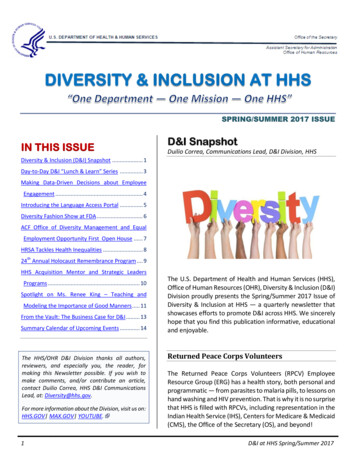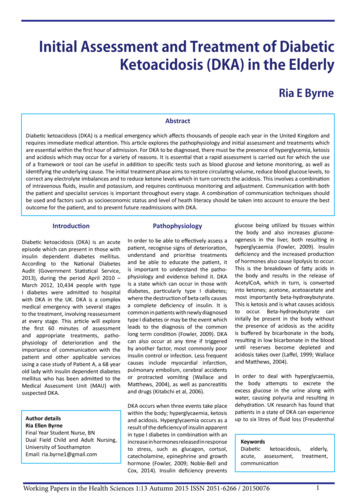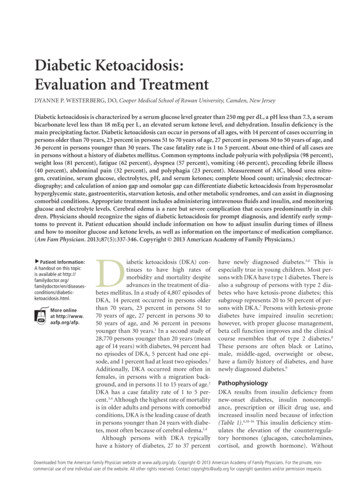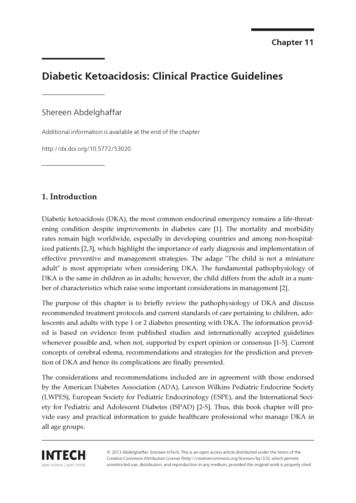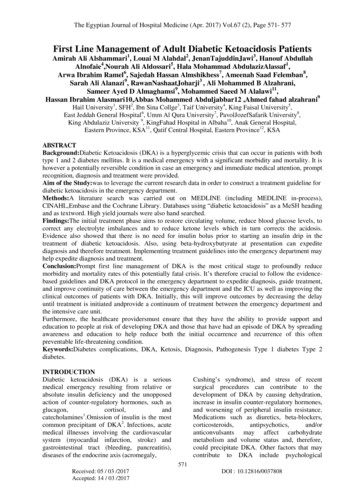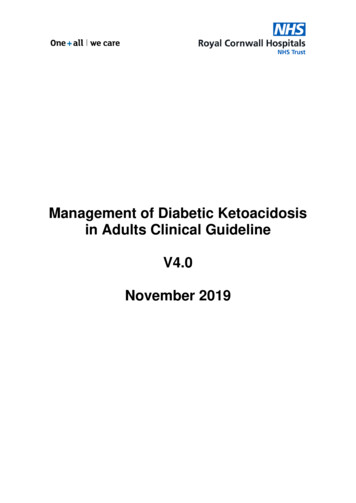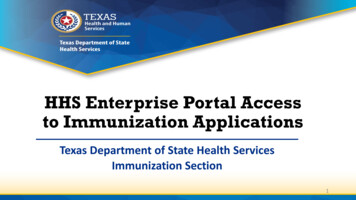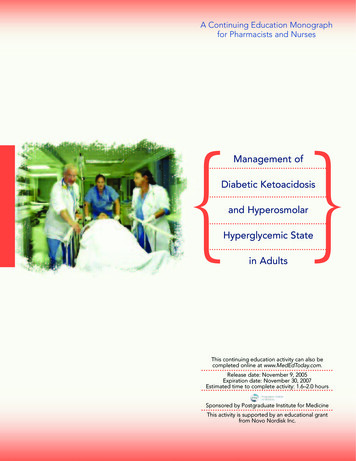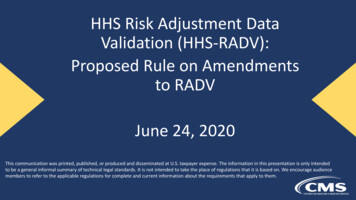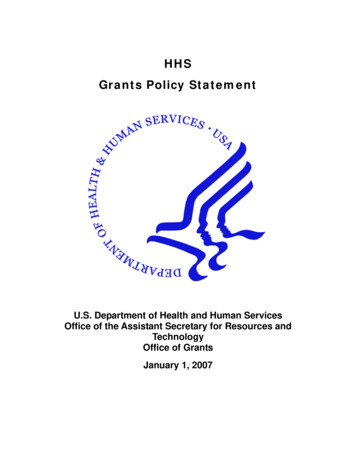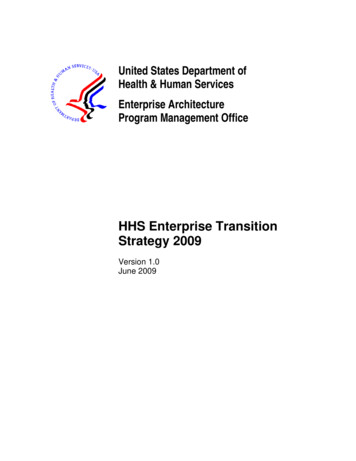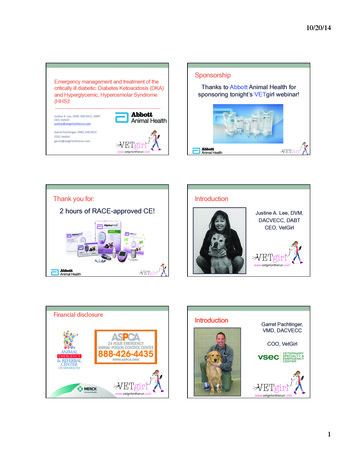
Transcription
10/20/14Emergency management and treatment of thecritically ill diabetic: Diabetes Ketoacidosis (DKA)and Hyperglycemic, Hyperosmolar Syndrome(HHS)!SponsorshipThanks to Abbott Animal Health forsponsoring tonight’s VETgirl webinar!Jus neA.Lee,DVM,DACVECC,DABTCEO,VetGirljus ne@vetgirlontherun.comGarretPach comThank you for:Introduction2 hours of RACE-approved CE!Financial disclosureJustine A. Lee, DVM,DACVECC, DABTCEO, VetGirlIntroductionGarret Pachtinger,VMD, DACVECCCOO, VetGirl1
10/20/14Subscription plansVETgirl on the RUN! The tech-saavy way to get CE credit! VETgirl Standard: 50-60 podcasts/year 99/year A subscription-based podcast & webinar service 4 hours of RACE-CEoffering veterinary RACE-approved CE VETgirl ELITE: 50-60 podcasts/year plus 20hours of webinars! 199/year 20 hours of RACE-CEFind us on social media!Download our podcasts on iTunes!BlogsandSocialMediaLogistics: CE inques onsEmailedtoyou48hoursaPerthewebinarAc vepar cipa on noquizWatchingvideolater,mustcompletequiz! ELITEmembersonlyEmail/contactwithANYques ons! garret@vetgirlontherun.com! jus ne@vetgirlontherun.com2
10/20/14Call in from your smartphone!Goals Definitions of DKA & HHS Treatment Pathophysiology Fluid therapy Diagnosis Electrolyte/acid-base Clinical signs Osmolality Insulin therapyDefinitionsDefinition of DKA DKA: Diabetic ketoacidosisDKA HHS: Hyperglycemic hyperosmolar syndrome Used to be called HONK (hyperosmolar tic)DKA and HHSAbsence of insulinNon-ketotic HHSIncreased glucagonSome insulin secretionIncreased diabetogenic hormonesIncreased diabetogenic hormonesOxidation of free fatty acidsNo oxidation of free fatty acidsKetonesNo ketonesFuel source of glucose"Glucagon resistanceMOA: glucosuria/ketonuria " osmotic diuresis "dehydration " hypovolemia " electrolyte abnormalitiesNo fuel source"MOA: Severe hyperglycemia and glucosuria " osmoticdiuresis " dehydration " hypovolemia "hyperosmolarity " electrolyte abnormalities3
10/20/14Diabetic Ketoacidosis: (DKA) Life-threatening:Hyperglycemic Hyperosmolar Syndrome: (HHS) Life-threatening: Acidosis DehydrationSevere hyperglycemia Hyperosmolarity Dehydration Concurrent disease Not always ketotic (or low levels) Treatment: More common in cats Lots of fluids Electrolytes Eventually .insulinthan dogsThe question remains Causes for DM " DKAConcurrent diseases: Can well-controlled diabetic patients becomeketoacidotic? Lack of insulin Fasting / Dehydration Stress hormones Glucagon Cortisol Epinephrine Growth hormone 600 mg/dl ( 33 mmol/L)Hyperosmolarity 350 mosm/kgSevere clinicaldehydrationLack of ketonesLactic acidosisCNS depression Cushings Prostatitis Hepatic lipidosis Skin disease Cholangiohepatitis UTI Pancreatitis Neoplasia CRF Pneumonia CHF Stress hormones "worsen hyperglycemiaDM " DKACANINE Concurrent diseases:DM " DKAFELINE Concurrent diseases:71% of dogs!!!93% of cats!!! Cushings Hepatic lipidosis Pancreatitis Cholangiohepatitis Neoplasia CRF UTI UTI / Infection Hypothyroid Neoplasia Pneumonia Pancreatitis4
10/20/14Causes: Diabetes Mellitus (DM)DogCat Genetics Islet amyloidosis Immune insulitis Obesity Pancreatitis Depo injections Obesity Infection InfectionClinical presentation Middle-aged to older PU/PD/PP (historical) Obesity (weight loss?) Weight loss Lethargy Polyphagia " Anorexia Dehydration Vomiting Concurrent Illness Muscle wasted Ketotic/acetone breath Concurrent illness Drugs (ovaban) Weakness Drugs (glucocorticoids) Pancreatitis Islet amyloidosis Genetics Immune insulitisBonder: 10 yo MC SiameseDiagnostic workup of DKAs PC: lethargy, anorexia, pu/pd X 3 days Big 4 (while drawing CBC/CHEM) PCV/TS/BG/Azo PE: 10% dehydrated5 kg3rd eyelids elevatedHR 180, RR 30, T 98.2 F (36.8 C)Slightly ictericDoughy abdomenSweet “acetone” breathInitial diagnostics Big 4 (draw CBC/CHEM at same time) PCV/TS (55%/9.8 g/dL (98 g/L), icteric serum) Blood glucose (BG) (680 mg/dL; 37.7 mmol/L) Azostick (BUN) (50-80 mg/dL; 35-57 mmol/L)) Venous blood gas (VBG) Within 2-3 minutes, identifies: Hemoconcentration Diabetes Serum ketones! Renal failure vs. pre-renal Metabolic acidosis elyte abnormalities Urine or serumketone dipstick“Ideal” diagnostic workup of DKAs CBC Chemistry Urinalysis Urine culture MIC Radiographs Chest Abdomen Abd. ultrasound Lipase/Amylase (dog) Coagulation panel Venous blood gas Electrolytes! Doppler5
10/20/14Typical DKA clinicopathologic findings Hemoconcentration Dehydration Anemia Anemia of chronicity GI blood loss Leukocytosis Left shift Increased LES Hyperglycemia Hypoxia Pancreatitis Underlying disease Azotemia Pre-renal Renal Metabolic acidosis Ketone bodies Urinalysis/Culture Glucosuria Ketonuria Bacteruria Specific gravity Lactic acid Uremic acids Electrolytes!Bonder’s resultsBonder’s blood results: CBC:Typical DKA clinicopathologic findings Diagnosis: WBC: 17,400 X 103/uL Inflammatory leukocytosis Neuts: 16,000 X 103/uL Underlying hepatic disease! Plts: Normal, clumped Hepatic lipidosis Slightly icteric plasma Cholangiohepatitis Pancreatitis CHEM: mg/dL / mmol/L BUN:61 /43 Creat:2.7 / 239 Tbili:1.8 / 30 µmol/L ALT:210 AST:175 Glucose: 656/ 36.4 Bicarb:7.0 mEq/L Na :135 mEq/L Cl-:95 mEq/L K :2.7 mEq/L P :2.6 /0.84 Diagnosis: Azotemia Icteric Increased LES Diabetes mellitus Metabolic acidosis Severe electrolyteabnormalities Hyperosmolar Treatment: IVFBonder’s results Urinalysis: Cystocentesis 1.025 pH 6.0 3 glucosuria 2 ketones (moderate) Ruleouts: Isosthenuria Renal disease Osmotic diuresis Ketonuria Glucosuria6
10/20/14Electrolyte disturbancesPotassium Clinical signs of hypokalemia: Muscle weakness Cervical ventroflexion (cats) Cardiac arrhythmias Respiratory muscle failureWhat happens with DM?Osmolar shiftinghyperglycemiaCellular shifting Supplement, supplement, supplement!Metabolic acidosisRenal lossAnd then consider. over-supplementing!Osmotic diuresisPoor oral intake Na, K, Cl, P, MgPotassium supplementationPotassium supplementationSerum K (mEq/L)K /Liter fluids 3.5203.0-3.5302.5-3.0402.0-2.560 2.080 5 kg cat on 50 ml/hr 1 liter bag of LRS 20 hours of IV fluids K supplementation formula: 0.5 mEq KCL/kg/hr 0.5 mEq KCL X 5 kgs 2.5 mEq KCl/hour 20 hours X 2.5 mEq KCl/hour 50 mEq KCL into the bag!**NOT recommended to exceed 0.5 mEq/kg/hrInsulin TherapyWhy over-supplement? Insulin drives potassium into cellsGlucosePhosphorusPotassium7
10/20/14Phosphorous Clinical signs of hypophosphatemia: Weakness, ataxia, seizures Acute hemolytic anemia 1.5 mg/dL (0.48 mmol/L)Fix electrolytes first! Fix electrolytes first Worry about insulin administration later! Same shifts as K (acidosis, insulin, urinary losses) Supplement as Potassium Phosphate 0.01-0.12 mmol/kg/hr CRI KCL KPhos at 50:50Osmolality: Sodium control For each 62 mg/dL in glucosemg/dL, 1 Na mEq/LOsmolality: Sodium control For each 3.4 mmol/L in glucosemg/dL, 1 Na mEq/L Is your patient hyponatremic or hyperglycemic? Bonder: Na 135 mEq/LBG: 656 mg/dL (36.4 mmol/L) Fluid shifts into intravascular space due to hyperglycemia 656 mg/dL/62 10.6 mg/dL Dilutes sodium and potassium Bonder’s Na 135 10.6 Corrected sodium of really 145mEq/L Is your patient hyponatremic or hyperglycemic? Bonder: Na 135 mEq/LBG: 656 mg/dL (36.4 mmol/L)Osmolality: Sodium control 2 (Na K ) BUN/2.8 Glucose/18 2 X Na Normal: 280-310 mOsm/kgOsmolality: Sodium controlCompare the two formulas: 2(Na K) BUN/2.8 Glucose/18 2*(Na) Bonder: Na : 135 mEq/L BUN: 61 mg/dL (43 mmol/L)K :2.7 mEq/LBG: 656 mg/dL Full formula: 275 22 36 333 mOsm/kg 2 (Na) 270 mOsm/kg " not very accurate!8
10/20/14SERUMTISSUEhyperosmolalityH2OBrain: idiogenic osmolesFluid therapy:decreased osmolalityhyperosmolalityH2OWhat other tests do you want to do in DKApatients? Chest radiographs Aspiration pneumonia Volume overloadWhat other tests do you want to do in DKApatients? Abdominal radiographs Lipase/amylase/c/fTLI/PLI Pancreatitis R/O renal insufficiency Coagulation DIC Thrombocytopenia Prolonged clotting AUS Pancreatitis Neoplasia Neoplasia Pancreatitis Underlying disease abscess MetastasisWhat other tests do you want to do in DKApatients?Cerebral edema/comaBonder’s blood results Coag: WNL FELV/FIV negative AXR: small kidneys mild decrease in cranialabdominal detail Ruleouts: Pancreatitis CXR: WNL Renal disease AUS: Mild pancreatitis9
10/20/14TREATMENT FOR DKA#1: Fluid therapyFluid choice LRS Needs hepatic conversion for bicarbonate generation Buffered Volume resuscitation/perfusion Treat for hypovolemia Replace the dehydration Maintenance ongoing losses 0.9% NaCl Acidifying Na too high? Correction of electrolyte disturbances Dilution of blood glucose Plasmalyte-148 Acetate/gluconate " bicarbonate buffer Contains magnesiumIsotonic CrystalloidsrystalloidsFluidCchoiceSolutionRing LRSersPlasmalyte 56PlasmalyteRPlasmalyte A;Norm te001647270Osmolarity31027011131229431010
10/20/14Isotonic CrystalloidsIV fluid effect on blood glucose50 mmol/L39 mmol/LFluid therapy: CalculationsShock: ml bolus to effect Dehydration: Maintenance: Ongoing Losses:ml/hrml/hrml/hr Initial Fluid Rateml/hrBonder: How much fluiddo we want to give him? Doppler on initial presentation: 70 mmHg Gave ¼ of a shock dose of crystalloid to improve bloodflow ¼ of 60 ml/kg ¼ of 60 (5kg) 75 mls 60-75 mls Norm-R over 30 minutes – 1 hour Reassess Doppler 110 mmHgAssessment: DehydrationClinical SignsEstimate ofdehydrationNormal 5%Dry mucous membranes5%Reduced skin turgor6-8%Increased heart rate8-10%Weak pulses10-12%Collapse, shock12-15%Bonder needs more! Maintenance ongoing losses (pu/pd) 5 kg X 60 ml/kg/24 hours 300 mls 13 ml/hour Replace dehydration over 24 hours 5 kg X 10% dehydration X 1000 ml 500 mls 20 mls/hour On-going losses PU/PD Severe pu!11
10/20/14Fluid resuscitationFluid resuscitation 13 mls/hour 22 mls/hour approximately: Reassess! Recheck PCV/TS, VBG, elytes, BG40 ml/hr crystalloid X 12 hours KCl KPhos Reassess based on: Physical examination PCV/TS (55%/98 g/L "40/70 " 35/60) Azo/BUN (61 mg/dL/43 mmol/L " improvement) Body weight (5 kgs at 10% dry) 5 kgs X 0.1 X 1000 500 mls 1 L 1000 mls After dehydration, should weigh 500 mls more 0.5 kgs Ideal weight: 5.5 kgsFluid therapy#By 48 hours: after hydration improved, to 30 ml/hr KCl KPhosMonitor that osmolality! Change it slowly! Correct sodium, water, and glucose derangements over8-12 hours (24 hours in cats!) Pick Na fluid closest to animal’s Na ! Wait to begin insulin therapyAssess hydration carefully! Diabetes: Sp. gravity 1.015-1.018 Urine volumeINSULIN THERAPY Drinking water in the cage12
10/20/14#2: Regular insulin therapy#2: Regular insulin therapy PROS: Fixes the blood glucose “#” right away CONS: Drops the blood glucose “#” too quickly, changing the osmolality tooquickly Provides cellular substrate by driving glucose intracellularly Drops the electrolytes too quickly " shifts K and P intracellularly Helps resolve the metabolic acidosis by providing substrateworsening clinical signs CRI insulin protocolInsulin therapyInsulin CRI(Regular Insulin)Cat- 1.1u/kg in 240ml 0.9% NaClDog- 2.2 u/kg in 240ml 0.9% NaCl Regular insulin until nonketotic CRI vs. intermittent IM protocolsBlood Glucose (mg/dL) Supplementation of glucose CAUTION: K , P , blood glucose, osmolalityCRI insulin protocolInsulin CRI(Regular Insulin)Cat- 1.1u/kg in 240ml 0.9% NaClDog- 2.2 u/kg in 240ml 0.9% NaCl 350 35010250-3497150-2495 2.5% dextrose100-1493 5% dextrose 1000CRI insulin protocol! Insulin is used to lower blood glucose and to halt ketone production.! Insulin administration should continue until ketosis has resolved, even if thismeans that glucose supplementation must be given to maintaineuglycemia.Blood Glucose(mg/dL)Insulin CRI (ml/hr)Insulin CRI (ml/hr)10250-3497150-2495 2.5% dextrose100-1493 5% dextrose 1000Blood Glucose(mg/dL/mmol/L)FluidsInsulin CRI (ml/hr)250 mg/dL13.9 mmol/L0.9% NaCl10200-250 mg/dL11-13.9 mmol/LNaCl 2.5% dextrose7150-200 mg/dL8.3-11 mmol/LNaCl 2.5% dextrose5100-150 mg/dL5.5-8.3 mmol/LNaCl 5% dextrose5 100 mg/dL 5.5 mmol/LNaCl 5% dextroseOFF13
10/20/14Intramuscular (IM) protocolIM insulin protocolIf BG is:Give: 250 mg/dL 13.9 mmol/Lunits regular insulin IM150-250 mg/dL8.3-13.9 mmol/LU insulin IM 2.5%dextrose to IVF100-150 mg/dL5.6 – 8.3 mmol/LU insulin IM 5%dextrose to IVF 100 mg/dL 5.6 mmol/LNo insulin; 5% dextrose inIVF Start with 0.2 U/kg, adjust based on glucose measurements Check blood glucose q 4 hours Insulin q 4 hours Slow correction Use small amt blood (esp cats), place central lineS. Buob et al (ACVIM 2010) An Intermittent Insulin Protocol ImprovesMetabolic Acidosis Faster Than a CRI of Regular Insulin in Feline DKAS. Buob et al (ACVIM 2010) An Intermittent Insulin Protocol ImprovesMetabolic Acidosis Faster Than a CRI of Regular Insulin in Feline DKA Human study: children with DKA: SQ glargine CRI of Intermittent: faster time to resolution of acidosis (16 hr vs.regular insulin " faster resolution of acidosis. Animal study: Evaluate SQ glargine IM regular insulin incats with DKA. N 16 cats (8 CRI; 8 intermittent insulin) "38 hrs) No differences were detected between the two groups for: hospitalization time nadir of the hematocrit (p 0.65) resolution of ketonemia (p 0.50) 11/16 survived14
10/20/14 N 12 The median time to biochemical resolution of DKA in dogstreated with lispro insulin was significantly shorter (26 h;range 26–50 h) than in dogs treated with regular insulin(61 h; range, 38–80 h, P 0.02). No adverse effects were observed in association with IV To characterize the use of lispro insulin in dogs with diabetes ketoacidosis(DKA) and to compare the length of time required for resolution ofhyperglycemia, ketosis, and acidosis, respectively, in dogs with DKAtreated with lispro or with regular insulin.PATIENT MONITORINGAND SUPPORTIVECARElispro insulin administration Treatment of DKA in dogs with IV CRI lispro insulin issafe, and as effective as treatment with regular insulin.Therapeutics IV catheterization Sampling line? Central line? TPN CVP Ease of blood drawIV accessTherapeutics Double or triple lumen Aseptic TPN CVP Ease of blood draw IV catheterization Fluid resuscitation Treat underlying infection Venocath (central line) Hindleg Jugular15
10/20/14Treat underlying infection Antibiotic therapy once UA/UC pulled! LOW-gun until culture !Therapeutics IV catheterization Fluid resuscitation Treat underlying infection Ampicillin 22 mg/kg IV q. 8 Cefazolin 22 mg/kg IV q. 8 Unasyn 25-30mg/kg IV q. 8Slowly treat the DKA: Bonder After 6-12 hours of IVF therapy, reassess for hydration Slowly treat DKA Regular insulin therapyPatient monitoring Blood glucose every 2-4 hours Body weight, TPR 2 units IM regular insulin q. 4 hours if BG 250-350 mg/dL (13.9-19.4 mmol/L) Electrolytes q 8-12 hours PCV/TS/AZO Blood pressure 1 unit IM regular insulin q. 4 hours if BG 150-250 mg/dL(8.3 – 13.9 mmol/L)Nutrition Great candidate for a FEEDING TUBE! NE tube Hydration (cardioprotective) 90 ml/kg/day Clinicare CRI’s or Vivonex Urine ketonesKey points to remember! Don’t start long-acting insulin until: Eating and drinking Improved attitude/hydration Normotensive No longer vomiting Clinical signs improved Clinicare: 1 kcal/ml Typical cat 200 kcal/day Start slow Day 1: ¼ of RER Day 2: ½ of RER Day 3: Full RER16
10/20/14Hyperglycemic Hyperosmolar Syndrome: (HHS) Life-threatening: DehydrationHHSSevere hyperglycemia Hyperosmolarity Not always ketotic (orHyperglycemic, Hyperosmolar Syndrome low levels) More common in catsthan dogsHyperglycemic Hyperosmolar Syndrome: (HHS) Severe hyperglycemia ( 600 mg/dl/33.3 mmol/L) Hyperosmolarity ( 350 mosm/kg) Severe clinical dehydration Lack of ketones (serum/urine) Lack of/mild acidosis CNS depression (lethargy)! 600 mg/dlHyperosmolarity 350 mosm/kgSevere clinicaldehydrationLack of ketonesLactic acidosisCNS depressionKoenig et al: Hyperglycemic, hyperosmolar syndromein feline diabetics: 17 cases (1995-2001) N 17 cats Criteria: hyperglycemic non-ketotic hyperosmolar syndrome HHS: calculated Osm 350, effective Osm 330, Glu 600, urine ketone negative.Koenig et al: Hyperglycemic, hyperosmolar syndrome infeline diabetics: 17 cases (1995-2001) PC: long-standing DM receiving insulin for many months; oldercats; presenting with: pu/pd, lethargyKoenig et al: Hyperglycemic, hyperosmolar syndrome infeline diabetics: 17 cases (1995-2001) Rarely found pancreatitis or hepatic disease with HHS PE findings: profound dehydration, lactic acidosis, azotemia 65% died or euthanized with 10 hours of presentation Serious concurrent disease in 15/17 cats (88%) " Neuro signs Long-term survival: 12% respiratory signs Renal failure Respiratory complications Congestive heart failure Infection Neoplasia GI diseasehttp://allpetcareanimalhospital.com/?p 2665117
10/20/14Hyperglycemic Hyperosmolar Syndrome: (HHS)Hyperglycemic Hyperosmolar Syndrome: (HHS) Don’t bolus fluids unless hypotensive! CAUTIOUS correction of hyperglycemia SLOW rehydration! Plasmalyte 148 or LRS CAREFUL with 0.45% NaCl or D5W Water bowl! Monitor mentation, electrolytes (sodium), blood glucoselevelsHyperglycemic Hyperosmolar Syndrome: (HHS) Don’t use Na Bicarbonate Too hyperosmolar!CONCLUSIONS Safest: oral water NE tube with oral water? Maintenance oral waterPitfallsPitfalls Never use insulin IM, IV unless regular insulin! When in doubt, slow correction of glucose! No SC insulin if dehydrated! No BIG guns pending culture! Central line for ease of patient Perfusion, perfusion, perfusion! Start on long-acting insulin once eating18
10/20/14Special thank you!Conclusions: What happens chronically, treat chronically. Appropriate client communication with DKA, HONK, DM Long-term managementThanks to Abbott Animal Health forsponsoring tonight’s VetGirlwebinar! Not all DKA require 24 hour care Don’t reach for insulin too early!Checkoutour2014- ‐2015upcomingVetGirlappearances!Questions?Dr. Justine Lee Merck October 29: Orlando, FL November 18: Minneapolis, MN@VetGirlOnTheRun International Veterinary Seminars November 10-12: Key West, FL NAVC 2015 WVC 2015Dr. Garret Pachtinger October 2014:VetGirlOnTheRunGarret@vetgirlontherun.comJus ne@vetgirlontherun.com Ralph Lee’s Great Smokies VeterinaryConference (Asheville, N.C.) NAVC 2015 WVC 2015This material is copyrighted by VetGirl, LLC. None of the materials provided may be used,reproduced or transmitted, in whole or in part, in any form or by any means, electronic orotherwise, including photocopying, recording or the use of any information storage andretrieval system, without the consent of VetGirl, LLC. Unless expressly stated otherwise, thefindings, interpretations and conclusions expressed do not necessarily represent the views ofVetGirl, LLC. Medical information here should be references by the practitioner prior to use.Under no circumstances shall VetGirl, LLC. be liable for any loss, damage, liability or expenseincurred or suffered that is claimed to have resulted from the use of the information providedincluding, without limitation, any fault, error, omission, interruption or delay with respectthereto. If you have any questions regarding the information provided, please contactinfo@vetgirlontherun.com19
10/20/14! 2! VETgirl on the RUN! The tech-saavy way to get CE credit! A subscription-based podcast & webinar service offering veterinary RACE-approved CE Subscription plans VETgirl Standard: 50-60 podcasts/year 99/year 4 hours of RACE-CE VETgirl ELITE: 50-60 podcasts/year plus 20 hours of webinars! 199/year
